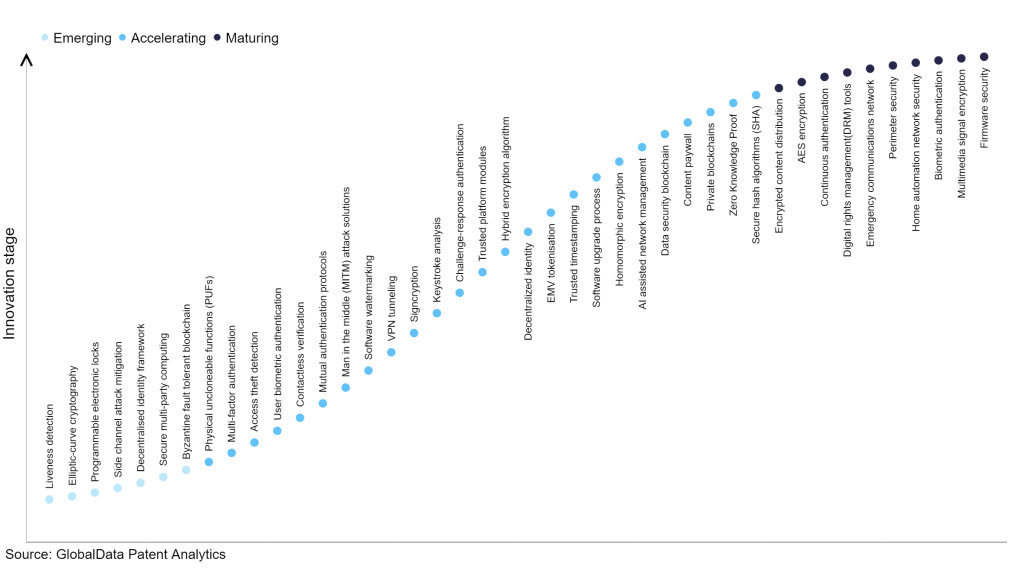The technology industry continues to be a hotbed of innovation, with activity driven by the increasing demand for secure hardware solutions, the rising concerns over intellectual property theft, and the need for secure authentication mechanisms, as well as growing importance of technologies such as silicon physical unclonable functions (PUFs), optical PUFs, and magnetic PUFs, which leverage physical phenomena to create unique and unclonable identifiers. These technologies contribute to strengthening hardware security, ensuring data integrity, and safeguarding critical systems from various cyber threats. In the last three years alone, there have been over 3.6 million patents filed and granted in the technology industry, according to GlobalData’s report on Innovation in Cybersecurity: Physical uncloneable functions (PUFs). Buy the report here.
However, not all innovations are equal and nor do they follow a constant upward trend. Instead, their evolution takes the form of an S-shaped curve that reflects their typical lifecycle from early emergence to accelerating adoption, before finally stabilising and reaching maturity.
Identifying where a particular innovation is on this journey, especially those that are in the emerging and accelerating stages, is essential for understanding their current level of adoption and the likely future trajectory and impact they will have.
300+ innovations will shape the technology industry
According to GlobalData’s Technology Foresights, which plots the S-curve for the technology industry using innovation intensity models built on over 2.5 million patents, there are 300+ innovation areas that will shape the future of the industry.
Within the emerging innovation stage, byzantine fault tolerant blockchain, secure multi-party computing, and decentralised identity framework are disruptive technologies that are in the early stages of application and should be tracked closely. Secure hash algorithms (SHA), zero knowledge proof, and private blockchains are some of the accelerating innovation areas, where adoption has been steadily increasing. Among maturing innovation areas are firmware security, multimedia signal encryption, and biometric authentication, which are now well established in the industry.
Innovation S-curve for cybersecurity in the technology industry

Physical unclonable functions (PUFs) is a key innovation area in cybersecurity
Physical unclonable functions (PUFs) are cryptographic primitives that utilise the distinctive physical attributes of a device to generate an unparalleled, unpredictable, and non-reproducible value. PUFs can rely on diverse physical properties, such as the electrical characteristics of an integrated circuit, the surface texture of an object, or the timing of sensor readings. These unique values serve as a secure means of authenticating the device or its user, ensuring robust security and protection against cloning or replication.
GlobalData’s analysis also uncovers the companies at the forefront of each innovation area and assesses the potential reach and impact of their patenting activity across different applications and geographies. According to GlobalData, there are 60+ companies, spanning technology vendors, established technology companies, and up-and-coming start-ups engaged in the development and application of physical unclonable functions (PUFs).
Key players in physical unclonable functions (PUFs) – a disruptive innovation in the technology industry
‘Application diversity’ measures the number of different applications identified for each relevant patent and broadly splits companies into either ‘niche’ or ‘diversified’ innovators.
‘Geographic reach’ refers to the number of different countries each relevant patent is registered in and reflects the breadth of geographic application intended, ranging from ‘global’ to ‘local’.
Patent volumes related to physical unclonable functions (PUFs)
Source: GlobalData Patent Analytics
Intel is one of the leading patents filers in physical unclonable functions (PUFs). The company’s patents are aimed at techniques and arrangements for provisioning keys to integrated circuits/processor.
In one embodiment, a key provisioner/tester apparatus may include a memory device to receive a unique hardware key generated by a first logic of a processor. The apparatus may further include a cipher device to permanently store an encrypted first key in non-volatile memory of the processor, detect whether the stored encrypted first key is valid, and to isolate at least one of the first logic and the non-volatile memory of the processor from all sources that are exterior to the processor in response to detecting that the stored encrypted first key is valid.
Other prominent patent filers in the space include ICTK and International Business Machines (IBM).
By geographic reach, IDEMIA France leads the pack, followed by Zwipe and eMemory Technology. In terms of application diversity, Everspin Technologies holds the top position, followed by AlpVision and Microchip Technology.
Cybersecurity innovation in physical unclonable functions (PUFs) has emerged as a cutting-edge approach to enhance hardware security. PUFs utilise inherent physical variations in electronic devices to generate unique identifiers that cannot be cloned or replicated. This technology offers robust protection against counterfeiting, tampering, and unauthorised access to sensitive data.
To further understand how cybersecurity is disrupting the technology industry, access GlobalData’s latest thematic research report on Cybersecurity – Thematic Research.
Data Insights
From

The gold standard of business intelligence.
Blending expert knowledge with cutting-edge technology, GlobalData’s unrivalled proprietary data will enable you to decode what’s happening in your market. You can make better informed decisions and gain a future-proof advantage over your competitors.







